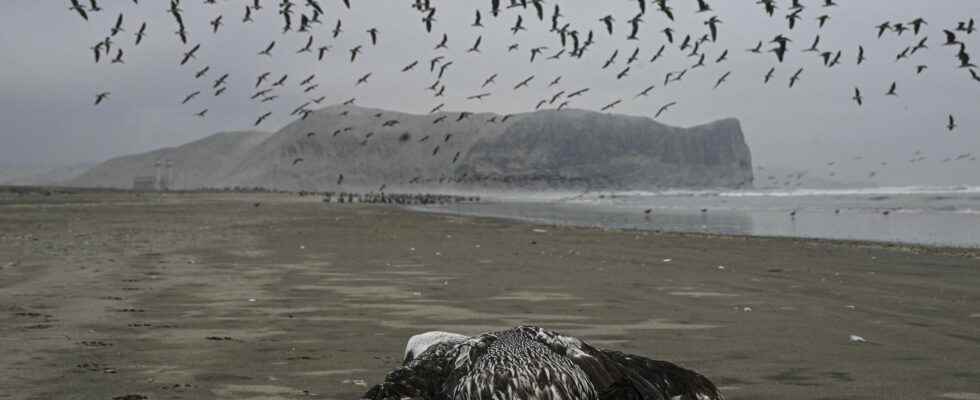By dint of spreading to new species, will the avian flu epidemic end up threatening humans and turning into a real pandemic? Concern is mounting in the United States but also in Europe. Because not only has the H5N1 virus been detected in more than a hundred mammals since last spring, but its spread among birds has reached an unprecedented level. The WHO called for vigilance on Wednesday against the transmission of avian flu to mammals but also wanted to be reassuring to calm fears of an H5N1 pandemic.
“I do not remember having witnessed a phenomenon of such magnitude in the past, confesses François Moutou, a former epidemiologist at ANSES now retired. Since 2021, the epidemic affecting birds has covered throughout Europe and North America. Japan is concerned, China too. Admittedly, the information varies in detail from one country to another, but the phenomenon extends to farms as well (poultry, ducks ) than wild birds (gannets, pelicans, terns, etc.). Such diversity is really something special”.
“We are still dealing with clade 2. 3. 4. 4B, the one that originated from the 1996 fowl plague virus. This goose pathogen responsible for the 2005 and 2006 crises continues to evolve and it is a mutation dated 2020 which explodes over the recent period”, specifies Jeanne Brugère-Picoux, veterinarian specializing in emerging diseases and member of the Academy of Medicine. The contamination of mammals is not in itself a novelty. That of big cats had been noted in zoos in Thailand as early as 2004. However, the accumulation of cases over the recent period (seals, ferrets, otters, raccoons, polecats, lynxes, bears, etc.) raises concerns. Above all, a Eurosurveillance report of January 19, 2023 describes the H5N1 infection of nearly 52,000 American mink on a farm in Galicia.
“Samples have shown that it was contamination by the virus that had raged among wild birds in the region before October. The partially open farm buildings may have allowed mink to come into contact with infected birds (or their droppings) attracted to distributed fish or chicken feed However, beyond the first infected cages, the report’s authors found subsequent contamination of other cages, suggesting transmission of the virus between minks. This would be the first observation of interspecies transmission of the avian influenza virus in a mammal”, summarizes Jeanne Brugère-Picoux.
No proven epidemic in mammals
Genetic sequencing of the isolated virus strain also showed that the animals were infected with a novel H5N1 variant comprising genetic material from a strain found in gulls, as well as a genetic change [mutation (T271A) sur PB2] known to increase the ability of some Influenza viruses to reproduce in mammals. This is why, very quickly, the Spanish authorities decided to euthanize all the mink. Scientists still keep a cool head. First of all, the eleven members of the breeding staff in contact with the animals all tested negative, no doubt due to the wearing of the compulsory mask since the appearance of clusters of Covid-19.
Then, all mammals that have been affected outside of this farm remain unique cases. As good predators, they consumed contaminated prey. There is, to date, no proven and documented epidemic in these mammals. Furthermore, there has been no observation of transmission between poultry and pigs, which nevertheless remain very sensitive to this type of virus. This also applies to China, where the physical proximity of species on farms or in markets facilitates this kind of passage.
Finally in Europe, the four human cases listed in recent years by the WHO have proven to be asymptomatic or mild compared to the two people affected in Asia. China does report a fatal case but which is not sufficiently well documented according to some scientists. “For humans to be infected, the virus must reach the alveoli and go beyond the first respiratory tract which is receptive to the fowl plague virus. In fact, we are protected so far by a species barrier which seems very very effective”, concludes Jeanne Brugère-Picoux.
Keep vigilance
“Even if H5N1 has changed since 2005 due to the appearance of variants, it remains rather adapted to birds and very little to mammals, abounds François Moutou. But relying on this protection does not mean that we must let our guard down.” On the one hand, we find this somewhat irrational fear that we had already known in 1996 and 2004. “At the time, a book even announced 500,000 deaths in France due to avian flu”, deplores Jeanne Brugère – Picoux. A prediction that fortunately did not come true.
But on the other hand, it is necessary to remain vigilant and to monitor the evolution of these viruses, believes the scientist. “If we let them circulate, this gives them more opportunities to multiply. However, we know that with each multiplication, small variations can lead to recombination which makes the virus more easily transmissible to mammals. Even if the probabilities are without doubt weak”, warns François Moutou. For this specialist, there is no doubt: the current situation should not last too long.
